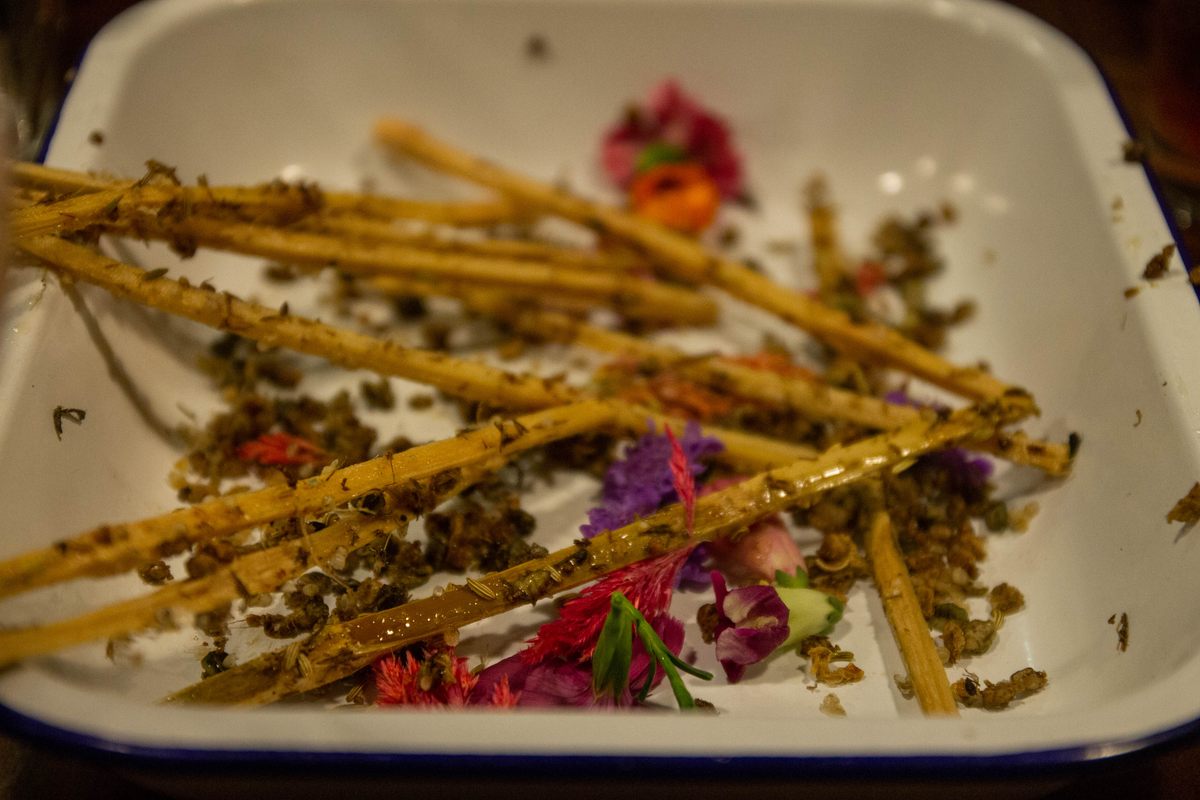
Roaches Taste Like Blue Cheese, and Other Bugsgiving Revelations
This Thanksgiving, why not feast on insects?
I had made a pact with two dining companions—we’d all eat our cockroaches at the same time. The insects had been served atop a bright-pink cranberry relish. There were 18 of them, most on their backs with their six legs akimbo, looking not dissimilar to the city cockroaches you might find dead behind a fridge. The association was a little off-putting, but since we’d already eaten 11 insect-laden dishes that evening, my fellow diners and I each speared a roach with a fork, raised it to our lips, and crunched into the chitin without fear.
The Thursday before Thanksgiving is, of course, Bugsgiving. Well, it is according to Joseph Yoon and David George Gordon, two chefs who specialize in edible insects. Bugsgiving, a ten-course banquet in which insects serve as the primary protein, took place in Williamsburg, Brooklyn, during the Brooklyn Bugs Festival. The three-day event, dreamed up by Yoon, debuted over Labor Day in 2017. This year, it was closer to Thanksgiving, hence the Bugsgiving banquet. The 2018 festival also featured bug-centric cooking demonstrations, a cocktail party, and a “Late Night Bugout” for the 21-plus crowd.
Before Bugsgiving, nary an insect had passed my lips—to my knowledge. Not a tequila worm nor a deep-fried tarantula, nor even an ant as part of a schoolyard dare. That said, I consider myself an adventurous eater. The only foods I cannot abide are licorice and raw celery. (Cooked celery, integrated within a soup or similar, is fine.) I have long believed I would rather eat literal ants on a log than “ants on a log.” Thankfully, Bugsgiving gave me the opportunity to prove this theory alongside 40 other diners, who ranged from entomologists eating their study subjects to curious chefs new to the world of insect-eating.

Tiny shards of ice pelted my eyeballs as I walked from the subway to Brooklyn Kitchen, a self-described “radical cooking school” standing in the shadow of the Brooklyn-Queens Expressway. After shedding my layers of coats—like a caterpillar shedding its skin, I thought, not that cleverly—I encountered an insect display manned by Louis Sorkin, an entomologist at the American Museum of Natural History. Sorkin placed a peppered roach (native to Central and northern South America; non-hissing) in one of my palms and a dazzlingly aquamarine-hued tobacco hornworm in the other. I would later eat one of these worms, blanched, torched, oven-roasted, and drizzled in hot sauce.
After a cocktail garnished with desiccated crickets, it was time for the banquet to begin.

Most current residents of the West are not sold on the idea of eating insects. But the same cannot be said for the rest of the world. From the witchetty grubs traditionally eaten by Aboriginal Australians to the maguey worms of Mexico, to the steamed silkworm pupae sold as street food in South Korea, to the termite ugali served with a Kenyan version of porridge, bug-based grub is no big deal. Yet Americans and Europeans are squeamish. (Pre-colonization, America was a different story. Up to 50 percent of Native communities incorporated insects into their diet in a range of dishes, from katydid fruitcake to cicadas fried in hog fat.)
In “Edible insects: Future prospects for food and feed security,” a 200-page report published in 2013, the UN’s Food and Agriculture Organization (FAO) noted that “Western societies require tailored media communication strategies and educational programmes that address the disgust factor” of eating insects. Bug banquets such as Bugsgiving offer one such educational opportunity. Yoon, who considers himself an “Edible Insect Ambassador,” focused on creating a family-style menu of dishes. “Instead of just serving crickets in a bowl or a chip, I want to serve black ants and shrimp, composed dishes—cricket gougères,” he says. “Things that represent a dish that [will make people] go, ‘Oh, that looks like food to me.’” Research cited by the UN proves that this strategy works: “Years of experimental experience in the Netherlands and the United States have confirmed the effectiveness of bug banquets in overcoming the disgust factor,” reads the 2013 FAO report.
Bugsgiving’s global and Native American-influenced menu made the evening less a tribute to pilgrims and colonizers, and more of an homage to the estimated two billion people around the world who eat insects as part of their traditional diet. Tradition, culture, and what we saw on the dinner table as kids generally determine what we are willing to eat as adults. To Gordon, eating chicken eggs is “about as weird as it gets. But we grew up with that, so it’s normal.”

The banquet was served in an open kitchen where diners could stand two feet from working chefs. Yoon happily chatted with onlookers while blowtorching Manchurian scorpions. Gordon wore a toque festooned with homemade antennae.
The appetizers each contained worms or caterpillars: mealworm fritters, skewered hornworms, and spoons of elote corn salad with maguey worms. Mealworms are the larval form of the mealworm beetle, whereas hornworms and maguey worms are, despite the terminology, edible caterpillars.
In all three cases, the insects were thoughtfully integrated into the appetizer. And the elote corn salad mixed many cultures in one bite, combining Mexican jalapenos with a Native American emphasis on corn, sumac from the Middle East, and a trip to East Asia via yuzu. Sure, it was a little jarring to see the occasional small worm embedded in the batter of the fritters, but it wasn’t as though I were scooping up caterpillars by the handful.

Next up was a pre-dinner sit-down course of “chimp sticks with black ants,” cricket gougères, and pear salad with Changbai ants. The chimp sticks are so named because they resemble the sticks chimpanzees use as tools to dig into ant nests. (The idea of creating a human-food homage came from the insect enthusiasts at the Nordic Food Lab.) For Bugsgiving, the chefs used raw sugar cane swizzle sticks, which, Gordon noted, you can buy on Amazon. The chefs coated the sticks with lerp, a crystallized honeydew secreted by plant lice in their larval stage, then sprinkled them with queen weaver ants and fennel seeds. Once my dining companions and I had eaten the ants, we instinctively chewed on the sticks like mischievous baby chimps to get at the liquid sugar inside.
A surprise discovery among many that evening: taste-wise, black ants are remarkably citrus-adjacent. They spray formic acid at predators, and formic acid tastes vaguely of sour orange.
The cricket gougères—button mushroom-sized choux pastries—commanded less attention, as they were made with mere cricket powder, and not topped with insects. They tasted good, but not distinctively insect-like.

Yoon refers to crickets as the “gateway bug.” They have “the most scientific research behind them, and are the most normalized insect in America,” he says. They also have the highest number of farms and the widest range of products in the United States. Those who are intrigued by insect eating but reluctant to eat recognizable bugs can opt for cricket chips, cricket protein bars, or use cricket flour to make cricket-battered fried chicken.
Worms, beetles, and locusts are more culturally enshrined as creepy pests in America, and less likely to be eaten. But the situation is improving, however slowly. Twenty years ago, when Gordon released the first edition of his Eat-a-Bug Cookbook, “I was kind of like the weirdo in the room,” he says. The release of the 2013 UN report, and its focus on sustainability, has shifted the conversation. An oft-quoted analogy among proponents is that eating a steak is like driving an SUV, and eating a bug is like riding a bicycle. According to Gordon, raising a turkey requires 468 gallons of water per pound, whereas raising a pound of crickets takes a single gallon.

The dinner course consisted of grasshopper kebabs, orzo with five-week-old crickets, garlic smashed potatoes with superworms, haricots verts with roasted beets and chapulines (small grasshoppers found in Mexico), and, the most challenging dish of the evening, cockroach-and-cranberry relish.
I did not particularly enjoy the relish. Visually, it was tricky. A Pepto-Bismol pink substance with the viscosity of hummus was topped with 18 or so Dubia roaches, their striped brown exoskeletons contrasting somewhat alarmingly with the pastel of the relish. The flavors clashed, too. The innards of a cockroach—or, at least, the Dubia roach, a species endemic to Central and South America—taste like blue cheese. And although blue cheese and cranberry can go together, the particular flavor of the cockroach didn’t complement the vibrant tartness of the cranberry. It’s a dish I wouldn’t be in a hurry to try again. But it was still better than raw celery.
Part of the challenge of marketing edible insects is the terminology. “Cockroach-and-cranberry relish” doesn’t quite have the fine-dining allure of a côte de boeuf or even a steak tartare. Thus far, there are few euphemistic terms for insects, but both Yoon and Gordon are hopeful that such words will come. People would much rather eat Chilean sea bass than Antarctic toothfish, points out Gordon. They’re the same animal.

No Thanksgiving is complete without a round of desserts. Instead of pumpkin pie, Bugsgiving served up worm-salt marshmallows with mezcal and orange, ice cream with cricket granola and berries, and figs with gorgonzola, honey, and wasps. The gorgonzola echoed the cockroaches of the previous course, which was a little unfortunate, but the salty marshmallows and powdery cricket granola proved more toothsome.
All up, it was a mind-expanding meal that I need to continue thinking about for approximately a week before making a more definitive ruling. But I’d eat insects again. In fact, I had a chocolate-flavored cricket protein bar the next morning.
And now, dear reader, a final piece of information for you. If you eat figs, then you’ve eaten bugs. Figs are pollinated by fig wasps, which lay their eggs inside the fruit. Then the eggs hatch. The young wasps make their way out and find other figs to burrow into, but the mother wasp remains. And dies. In the fig you eat. You’re most likely already an insect eater. Why not explore a wider range of edible bugs?
Gastro Obscura covers the world’s most wondrous food and drink.
Sign up for our email, delivered twice a week.




























Follow us on Twitter to get the latest on the world's hidden wonders.
Like us on Facebook to get the latest on the world's hidden wonders.
Follow us on Twitter Like us on Facebook